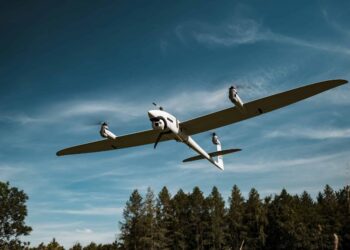US Air Force,
HANSCOM AIR FORCE BASE, MA: The mention of an airborne network conveys the sense of one monolithic entity, and someday, if all goes well, that is what it will be.
Right now, however, “we have a lot of disparate networks,” Mike Therrien, Airborne Networking division chief, told the Hanscom Representatives Association members at their monthly luncheon meeting Feb. 12. “Connecting them all is something that has to be done incrementally.”
Mr. Therrien spoke about the need to connect the command and control world with the intelligence, surveillance and reconnaissance world. One aspect of this involves unmanned aircraft. While the U.S. is adding more and more UASs to the fleet, and into theater, their ultimate utility depends on others gaining speedy access to the information they collect.
While discussing the networking challenge, Mr. Therrien offered a scenario involving ground troops in Afghanistan calling in close-air support.
“It's high in the mountains, so there's a lot of blockage, a lot of things you can't see,” he said. “I'm flying the A-10 coming in and I still don't know where you are, and it's not quiet, so (the enemy forces) can hear it coming. So I fly by once, because no one's passing me any information.
I'm hoping I can talk to you, but maybe I can't talk or you keep breaking up every time I bend or go around a curve. So I fly by and, OK, I see where you are now, but then I need another pass to get an exact reference point and to see where the enemy is. If I get it on the second pass, maybe I can release, but I may not be able to get it, so then I have to come around a third time. You want to guess where the enemy is by then?”
Gone, of course. That is why improving the network is so important.
“And that is why we are working hard at putting an aerial-interim gateway capability in theater to ensure connectivity,” he said.
Mr. Therrien spoke specifically about many of the pieces. Among them are the challenges of connecting the so-called low-observables, the F-22 Raptor, F-35 and B-2 Spirit, to one another and to the rest of network, and of fielding the multi-purpose aerial data link, MADL, intended to accomplish this.
The Office of the Undersecretary of Defense for Acquisition, Technology and Logistics directed the Air Force and Navy to integrate MADL among all three platforms, he said.
“The way it was going to work was the F-35 would develop the waveform, turn it over the fence and give it to the F-22; they'll integrate it, and in turn, they'll turn it over to the B-2 and they'll integrate it.”
ESC proposed an enterprise approach, Mr. Therrien said. That approach would have put the center in charge of creating and managing the waveform, standardizing messages and participating in interoperability testing.
“The answer [from OSD] came back: 'good idea, ESC, but you didn't go far enough,” he said. They instead wanted ESC to be fully in charge of the waveform and to serve as the single point of contact for the customer, Air Combat Command.
“ACC will come to us and tell us what they want, and we, in turn, will work with the platform managers and say, 'here's what we want integrated into the system' – and we'll be responsible for the specs and everything else.”
While that means a lot of additional work for Mr. Therrien's team, and other members of the 653rd Electronic Systems Group, it's only one component of this overarching effort to cobble together a comprehensive airborne network.
He went over a number of studies on various aspects, detailing both results and the decisions that are now stemming from them.
Mr. Therrien also spoke about the value of cooperative, research and development agreements, emphasizing that both government and industry need to figure out what their return on investment will be.
“Before we develop a CRADA, we should figure out where it's going to fit into the master plan, rather than just doing it and then saying we'll try to figure out later how it might help.”
The bottom line to all of this, he said, is there's now a new way of doing business.
“Before, I would say airborne network and it would be this nebulous thing – and I'm going to go do some stuff, but is anything really going to happen? Now we're really trying to move forward and to build a solid business case as to how to put all these pieces together,” Mr. Therrien said.









